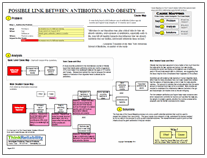On September 22, 2015, the Institute of Medicine (IOM) released a report entitled “Improving Diagnosis in Health Care“. To achieve that goal, the committee, “developed a conceptual model to articulate the diagnostic process, describe work system factors that influence this process, and identify opportunities to improve the diagnostic process and outcomes.”

A Process Map is similar to a geographical map in that it can provide different levels of detail while remaining accurate. For example, a map of a country as a whole typically contains only the most major roads, a map of a city will contain far more roads, and an inset providing detail of a section of the city may contain all the roads. All these maps are accurate; but the city map contains more detail than the national map.
Similarly, an overview of the diagnostic process can be summarized in just four steps: patient reporting of a health problem, information gathering and analysis, diagnosis, and treatment. By adding more detail to this process, the responsive nature of the process is revealed – if sufficient information is not gathered to make a working diagnosis, the process returns to the information gathering step. A similar “decision point” is made after treatment – if treatment is found to be ineffective, the process again returns to the information gathering step for another look at the diagnosis.
Even more detail can be provided about the information gathering step. Information gathering typically involves a clinical history/ interview, a physical exam, diagnostic testing and/or imaging, and referral or consultation with other health care professionals. As the information gathering step can be broken down into more detail, so can the diagnostic testing/ imaging step. In more detail, the diagnostic testing/ imaging step involves ordering diagnostic tests and/or imaging, preparation and collection of the specimen/image, examination of the specimen/ image, result interpretation, follow-up, and incorporating the results into the patient’s medical record. (Because of the similarities at a high level between the diagnostic testing and diagnostic imaging processes, they have been combined in the Process Map on the PDF, but a more detailed process would have separate steps for each.)
When analyzing a complex process, such as the diagnosis process, breaking it down into steps allows for an analysis of problems that occur at each step. Next week, our blog will discuss in more detail the impacts from diagnostic error, potential causes of diagnostic error, and the recommendations from the IOM report to improve diagnosis and reduce diagnostic error.
To view the diagnostic process map at several levels of detail, click on “Download PDF” above. Click here to read the Institute of Medicine report “Improving Diagnosis in Health Care.”









